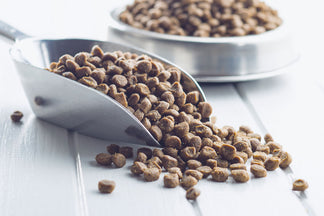If you’ve ever scratched your head over all the ingredients present in the unending varieties of pet food, feeling unsure of what’s good or bad for your pet, scratch no more! With Petnet’s pet food rating system, we do the hard work for you.
The rating system uses six crucial criteria to produce a rating out of 100, with lower ratings denoting an unhealthier food and higher ratings denoting a healthier food.
For instance, Dom the Frenchie was absolutely convinced that his go-to pet food, “Chateaux du Chien,” was the best dog food on the planet. It had lamb from New Zealand, salmon from Scotland, Kobe beef from Japan, golden maize from Argentina, and crisp lettuce from Yuma…
But he found out that “Chateaux du Chien” had only a 27 out of 100 Petnet rating. Oops. Sorry, Dom. Turns out, all of those fancy ingredients weren't really in his food. Instead, there were things like “Kobe beef flavor” instead of the real thing.

Hopefully, your pet’s food won’t be like Dom’s. But if it is, no worries. That’s what the rating system is for, to make it easier for pet owners to make better feeding decisions for their pets.
The following is a score breakdown of these 6 crucial criteria, which are rated on a scale of 0 to 100, 0 being in low quantity and 100 in high quantity.
1. High quality protein.
Protein is probably the most important aspect we assess in a pet food. We look for recognized, whole protein sources like salmon or beef, instead of by-products, vegetable-based proteins, and vague protein sources like “poultry.”
2. Species-appropriate macronutrients.
Dogs and especially cats thrive on a diet low in carbohydrates and high in proteins and fats. We assess how much a pet food corresponds to this specific diet.
3. Fruits and vegetables.
Fruits and veggies are the best source of vitamins and minerals. Pet foods packed with fruits and vegetables are greatly beneficial to a pet’s health.
4. Healthy oils and spices.
We want healthy oils and spices in our pets’ diets, since they are great for the pet's skin and coat and aid in digestion and other important functions.
5. No artificial ingredients and fillers.
Artificial ingredients are not appropriate in our pet's diets and in some cases can pose long-term risks. Filler ingredients like corn, soy, or gluten are also not appropriate for them.
6. No added sweeteners.
Added sweeteners are often used to mask the taste of lower quality food and offer no nutritional benefit to our pets.
The amount and quality of protein present in a pet food ultimately have a big impact on the final score, but each of these 6 criteria contribute to the Petnet food score, which we created to provide you with a clear idea of how pet foods stack up.


 Food
Food
 Food
Food
 Food
Food
